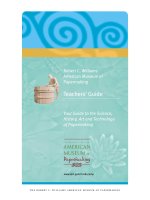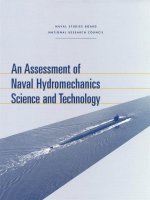SCIENCE AND TECHNOLOGY OF CASTING PROCESSES_1 ppt
Bạn đang xem bản rút gọn của tài liệu. Xem và tải ngay bản đầy đủ của tài liệu tại đây (36.58 MB, 176 trang )
SCIENCE AND
TECHNOLOGY OF
CASTING PROCESSES
Edited by Malur Srinivasan
Science and Technology of Casting Processes
/>Edited by Malur Srinivasan
Contributors
Limei Tian, Zhaoguo Bu, Zhihua Gao, Na Li, Edgardo Roque Benavidez, Sebastian Friedhelm Fischer, Andreas Bührig-
Polaczek, Ioan Ruja, Constantin Marta, Doina Frunzaverde, Monica Rosu, Ram Prasad, Malur Narayanaswamy
Srinivasan, Subramanyam Seetharamu, Tasaki, Qing Liu, Xiaofeng Zhang, Shinichiro Komatsu, Ramaprasad
( M.S.Ramaprasad) Meenasamudram Seshadri
Published by InTech
Janeza Trdine 9, 51000 Rijeka, Croatia
Copyright © 2012 InTech
All chapters are Open Access distributed under the Creative Commons Attribution 3.0 license, which allows users to
download, copy and build upon published articles even for commercial purposes, as long as the author and publisher
are properly credited, which ensures maximum dissemination and a wider impact of our publications. After this work
has been published by InTech, authors have the right to republish it, in whole or part, in any publication of which they
are the author, and to make other personal use of the work. Any republication, referencing or personal use of the
work must explicitly identify the original source.
Notice
Statements and opinions expressed in the chapters are these of the individual contributors and not necessarily those
of the editors or publisher. No responsibility is accepted for the accuracy of information contained in the published
chapters. The publisher assumes no responsibility for any damage or injury to persons or property arising out of the
use of any materials, instructions, methods or ideas contained in the book.
Publishing Process Manager Iva Lipovic
Technical Editor InTech DTP team
Cover InTech Design team
First published October, 2012
Printed in Croatia
A free online edition of this book is available at www.intechopen.com
Additional hard copies can be obtained from
Science and Technology of Casting Processes, Edited by Malur Srinivasan
p. cm.
ISBN 978-953-51-0774-3
free online editions of InTech
Books and Journals can be found at
www.intechopen.com
Contents
Preface VII
Section 1 Disposable Mold Castings 1
Chapter 1 Sand Mold Press Casting with Metal
Pressure Control System 3
Ryosuke Tasaki, Yoshiyuki Noda, Kunihiro Hashimoto and Kazuhiko
Terashima
Chapter 2 Progress in Investment Castings 25
Ram Prasad
Chapter 3 New Casting Method of Bionic Non-Smooth Surface on
the Complex Casts 73
Tian Limei, Bu Zhaoguo and Gao Zhihua
Chapter 4 Evaluation and Modification of the Block Mould Casting
Process Enabling the Flexible Production of Small Batches
of Complex Castings 87
Sebastian F. Fischer and Andreas Bührig-Polaczek
Section 2 Reusable Mold Castings 115
Chapter 5 Permanent Molding of Cast Irons –
Present Status and Scope 117
M. S. Ramaprasad and Malur N. Srinivasan
Chapter 6 Control Technology of Solidification and Cooling in the Process
of Continuous Casting of Steel 169
Qing Liu, Xiaofeng Zhang, Bin Wang and Bao Wang
Chapter 7 Mould Fluxes in the Steel Continuous Casting Process 205
Elena Brandaleze, Gustavo Di Gresia, Leandro Santini, Alejandro
Martín and Edgardo Benavidez
Section 3 Evaluation of Castings 235
Chapter 8 Segregation of P in Sub-Rapid Solidified Steels 237
Na Li, Shuang Zhang, Jun Qiao, Lulu Zhai, Qian Xu, Junwei Zhang,
Shengli Li, Zhenyu Liu, Xianghua Liu and Guodong Wang
Chapter 9 Accuracy Improving Methods in Estimation of Graphite
Nodularity of Ductile Cast Iron by Measurement
of Ultrasonic Velocity 265
Minoru Hatate, Tohru Nobuki and Shinichiro Komatsu
Chapter 10 Fracture Toughness of Metal Castings 285
M. Srinivasan and S. Seetharamu
Chapter 11 Research on Simulation and Casting of Mechanical Parts Made
of Wear-and-Tear-Resistant Steels 313
Ioan Ruja, Constantin Marta, Doina Frunzăverde and Monica Roşu
ContentsVI
Preface
Casting process is the most direct method of producing a product from the chosen material.
Though products in all the three major classes of materials, metals, ceramics and polymers
can be produced by this method, casting of metals is by far the most widely used process.
The basic steps in the casting process are preparation of the material in the liquid state,
transferring the liquid material into a shaping mold, allowing the transformation of liquid
material in the mold into a solid form. The solid object can then be used directly in
applications or subjected to secondary operations like thermal treatment involving solid
state transformations or material removal. In one important case (continuous casting), the
solid is subjected to significant plastic deformation to get the final shape of the object. In
recent times, innovations have been developed to process some metallic materials in a semi-
solid form, giving rise to interesting behavior of the castings.
As with any other process, the factors affecting the casting process are the quality, the cost
and the environmental effects. The choice of a given casting process will have to be made
consistent with acceptable levels of the degree of combination of these factors. Several
alternatives may be available to make a cast product, as for example, a sand casting or a
permanent mold casting, as the latter may have a lesser environmental impact. The decision
may not be a straightforward one, as factors such as molten metal temperature and casting
size may favor the sand casting process. On the other hand, the product quality of a
permanent mold casting may be better than that of a sand casting. It follows therefore that a
careful analysis of the science and technology of each process is extremely important. In
view of the complexity of each, it is advisable to undertake separate studies of each and
later, based on a suitable combination, choose a process that leads best towards the goal of
high quality, low cost and low environmental impact.
The science of metal casting mainly deals with control of fluid mechanics and heat transfer
at the macro-level and the additional control of mass transfer both at the micro-level and
macro-level. All the three factors are interwoven but each is capable of independent analysis
before integration with others. Also, to conform to the designer's requirements, an
engineered casting must possess acceptable level of properties, the mechanical properties
often being most important. Solid mechanics mainly governs the mechanical behavior of
castings. The technology used deals with both cost and environmental aspects, consistent
with the proper application of the scientific factors. Needless to say, the goal of attaining
high quality, low cost and low environmental impact in a casting process is not easy and
requires extensive research and understanding in each area. Obviously, proper evaluation
procedures must be established to assess the quality, reliability and serviceability of the
castings.
This book is a collection of chapters contributed by experts in their fields. The effect of
environmental impact is recognized in two chapters but in view of the growing global
concerns, it is desirable to have more extensive documentation of this factor and its
interaction with the science and processing of castings.
Prof. Malur Srinivasan
Professor of Mechanical
Lamar University
Texas, USA.
PrefaceVIII
Section 1
Disposable Mold Castings
Chapter 1
Sand Mold Press Casting with Metal Pressure Control
System
Ryosuke Tasaki, Yoshiyuki Noda,
Kunihiro Hashimoto and Kazuhiko Terashima
Additional information is available at the end of the chapter
/>1. Introduction
A new casting method, called the press casting process, has been developed by our group in
recent years. In this process, the ladle first pours molten metal into the lower (drag) mold.
After pouring, the upper (cope) mold is lowered to press the metal into the cavity. This
process has enabled us to enhance the production yield rate from 70% to over 95%, because
a sprue cup and runner are not required in the casting plan [1]. In the casting process, mol‐
ten metal must be precisely and quickly poured into the lower mold. Weight controls of the
pouring process have been proposed in very interesting recent studies by Noda et al. [2].
However, in the pressing part of the casting process, casting defects can be caused by the
pattern of pressing velocity. For example, the brake drum shown in Fig. 1 was produced
with the press casting method. Since the molten metal was pressed at high speed, the prod‐
uct had a rough surface. This type of surface defect in which molten metal seeps through
sand particles of the greensand mold and then solidifies, is called Metal Penetration. Metal
penetration is most likely caused by the high pressure that molten metal generates, and it
necessitates an additional step of surface finishing at the least. Thus, the product quality
must be stabilized by the suppression of excess pressure in the high-speed press. For short-
cycle-time of production, a high-speed pressing control that considers the fluid pressure in
the mold is needed. Pressure control techniques have been proposed for different casting
methods [3-4]. In the injection molding process, the pressure control problem has been suc‐
cessfully resolved by computer simulation analysis using optimization technique by Hu et
al. [5] and Terashima et al. [6]. Furthermore, a model based on PID gain selection has been
proposed for pressure control in the filling process. Although the pressure in the mold must
be detected in order to control the process adequately using feedback control, it is difficult
© 2012 Tasaki et al.; licensee InTech. This is an open access article distributed under the terms of the Creative
Commons Attribution License ( which permits unrestricted use,
distribution, and reproduction in any medium, provided the original work is properly cited.
to measure the fluid pressure, because the high temperature of the molten metal (T ≥ 1200 K)
precludes the use of a pressure sensor. Thus, in our previous papers by Tasaki et al. [7], the
pressure during pressing at a lower pressing velocity was estimated by using a simply con‐
structed model of molten metal’s pressure based on analytical results of CFD: Computation‐
al Fluid Dynamics. A new sequential pressing control, namely, a feed forward method using
a novel simplified press model, has been reported by the authors of Ref. [7]. It has been
shown that this method is very effective for adjusting pressure in the mold. However, in the
previous paper, the actual unstationary flow and the temperature drop during pressing was
not considered; a detailed analysis that considers the temperature change during pressing is
required to reliably predict and control the process behaviors.
Figure 1. Pouring and pressing processes in press casting.
In this chapter, a novel mathematical model with the pressure loss term of fluid in vertical
unstationary flow is derived by assuming that the incompressible viscous flow depends on
the temperature drop of the molten metal. The model error for the real fluid’s pressure is
minimized by the use of parameter identification for the friction coefficient at the wall sur‐
face (the sole unknown parameter). Furthermore, the designed velocity of the switching pat‐
tern is sequentially calculated by using the maximum values of static, dynamic, and friction
pressure, depending on the situation in each flow path during the press. An optimum de‐
sign and a robust design of pressing velocity using a switching control are proposed for sat‐
isfying pressure constraint and shortening the operation time. As a final step in this study,
we used CFD to check the control performance using control inputs of the obtained multi-
step pressing pattern without a trial-and-error process.
2. Pressing Process in Press Casting
The upper mold consists of a greensand mold and a molding box. The convex part of the
upper mold has several passages that are called overflow area, as shown in Fig. 2. Molten
metal that exceeds the product volume flows into the overflow areas during pressing. These
areas are the only parts of the casting plan that provide the effect of head pressure. As the
diagram shows, these are long and narrow channels. When fluid flows into such the area,
high pressurization will cause a casting defect. Therefore, it is important to control the press‐
ing velocity in order to suppress the rapid increase in pressure that occurs in high-speed
Science and Technology of Casting Processes4
pressing. The upper mold moves up and down by means of a press cylinder and servomo‐
tor. The position of the upper mold can be continuously measured due to encoder set in the
servo cylinder to control molten metal pressure.
Figure 2. Diagrammatic illustration of pressing.
3. Modeling and Switching Control of Pressure
The online estimation of pressure inside the mold is necessary in the press casting system.
The CFD analysis, based on the exact model of a Navier-Stokes equation, is very effective for
analyzing fluid behavior offline and is useful for predicting the behavior and optimizing a
casting plan. However, it is not sufficient for the design of a pressing velocity control or for
the production of various mold shapes, because the exact model calculation would take too
much time. Therefore, construction of a novel simple mathematical model for the control de‐
sign in real time is needed in order to realize real-time pressure control. A simplified mold
shape is shown in Fig. 3, where b
i
and d
i
are the height and the diameter, respectively. P
B
is
the pressure of the molten metal on a defect generation part where the pressure will cause a
defect. The pressure fluctuation during pressing is approximated by a brief pressure model
for an ideal fluid; i.e., an incompressible and viscous fluid is assumed. Here, e
h
(t) in Fig. 3 is
the fluid level from under the surface of the upper mold. The head pressure of P
B
is directly
derived from e
h
(t). The press distance z(t) of the upper mold is the distance that the upper
mold must travel until it makes the bottom thickness of the product with the poured fluid in
the lower mold. By increasing the pressing velocity or the flowing fluid velocity, the dynam‐
ical pressure changes rapidly by the effect of liquidity pressure. The hydrodynamic pressure
for the peak fluid height is then involved in determining P
B
. Therefore, P
B
depends on the
head and hydrodynamic pressure determined by using Bernoulli’s theorem, and the pres‐
sure loss by viscosity flow friction is represented by the following equation:
Sand Mold Press Casting with Metal Pressure Control System
/>5
P
b
(t)=ρge
h
(t) +
ρ
2
(
1 + λ(T )
l(e
h
)
d(e
h
)
)
e
˙
h
(t)
2
(1)
Figure 3. Mold shape and flow pass change.
where ρ[kg/m
3
] is the density of fluid and g[m/s
2
] is the acceleration of gravity. The adjusta‐
ble parameter λ is the coefficient of the fluid friction depending on the fluid temperature,
and l(e
h
) is the mold wall height of the part that causes shear stress in the vertical direction.
The surface area of the flow channel decided by the mold shape is represented by D
i
(i=1,2,3),
and D
i
changes as D
1
= d
2
-d
1
; D
2
= d
3
- d
1
; D
1
= d
4
/n during pressing. The number of overflow
areas is represented by n. By the second term on the right-hand side in Eq. 1, the pressure P
B
will rise rapidly due to the increasing fluid velocity when fluid flows into the overflow
areas. The validity of the proposed pressure model as expressed by Eq. 1 was checked with
several CFD simulations in our previous paper[7] under such the condition that temperature
of molten metal is constant. The friction coefficient λ was then uniquely identified by a pa‐
rameter identification fitting with the results derived from the CFD model. We have pro‐
posed a switching control for the pressing velocity to suppress the pressure increase. Thus,
the pressing velocity necessary to suppress the pressure for defect-free production must be
determined and implemented. Here, a multi-switching velocity pattern can be obtained us‐
ing the following equation, and derived from the pressure model.
z
˙
k
=
2
(
P
Blim
−ρgh
uk
)
ρmax
(
A
Sk
2
/
A
Mk
2
)
(
1 + λh
uk
/
D
k
)
(2)
where the k
th
(k = 0,1, )-step velocity is decided in order that the maximum velocity satisfies
the desired pressure constraint P
Blim
[Pa]. Because the diameter D
k
and square ratio of surface
Science and Technology of Casting Processes6
area (A
Sk
/A
Mk
)
2
discontinuously change by each stage during pressing as shown in Fig. 3, a
multi-switch velocity control is adopted. The number k of steps of pressing velocity with
multi-switching can be determined by the mold shape in the case of Fig. 4, with the maxi‐
mum value of k being 3. z
˙
0
is the initial pressing velocity up until the point when the bottom
surface of the upper mold contacts the top surface of the poured fluid. Derivation of Eq. 2 is
straightforwardly calculated, and is omitted due to the paper space limitation.
When the pressing velocity changes from z
˙
k
to z
˙
k +1
[m/s], the pressing distance z[m] is given
by information of the mold shape and poured fluid volume. The design of the sequential ve‐
locity pattern such as the multi-switch point and each velocity must be adapted to particular
mold shape. In the next pressing simulation, a switching velocity input is sequentially de‐
signed as shown in Fig. 4, where the press velocity pattern is formed as a trapezoidal shape
by the switching position H
uk
and the pressing acceleration a[m/s
2
]. The control performance
using the switching velocity of Eq. 2 designed by the proposed simple model was reasona‐
bly validated by CFD simulation as shown in Fig. 5. Although the flowing fluid has 3 flow
pass stages during pressing for the mold shown in Fig. 3, the designed switching velocity
pattern switches only 1 time. This is meant to set a maximum velocity of 50[mm/s] for z
˙
1
at
the 1
st
stage andz
˙
2
at the 2
nd
stage to suppress extremely turbulent flow. z
˙
3
at the 3
rd
stage of
the narrow flow pass is then set to 6.9[mm/s]. Here the pressing acceleration is set to 1.5[m/
s
2
], and the total distance of pressing is 15[mm]. The molten metal properties in these simu‐
lations are shown in Table 1. The both pressure fluctuations as show in Fig.5 are satisfied
under the pressure constraint value assumed as 10[kPa]. This pressure constraint value has
been previously decided by using both the actual experimental test and the CFD analysis re‐
sults of the press with several constant velocity patterns using molten metal.
Figure 4. Pressing input shaped by trapezoidal velocities.
In the next chapter, parameter identification of λ [-] will be shown for each simulation con‐
dition to consider the pressure increase suppression for viscous fluid with a temperature de‐
crease. Pressure has been rapidly increased while liquid flows into narrow pass d(e
h
)[m]
such that stage-3 in Fig. 3. As seen from Eq. 1, the effect of λ on the variation of pressure
P
b
(t) becomes larger with the increase of liquid level e
h
[m] and flow velocity e
˙
h
[m/s]. Thus,
Sand Mold Press Casting with Metal Pressure Control System
/>7
exact value of λ(T) must be given for the region of e
h
and e
˙
h
, because our purpose is to sup‐
press the maximum pressure value. Therefore the fitting identification should be considered
for only the flow during a short period in stage-3. Then, T(t) is the lowest temperature dur‐
ing pressing because of the end time of pressing.
Density (const.) 7000 [kg/m
3
]
Viscosity (T=1673) 0.02 [Pa∙s]
Viscosity (T=1423) 0.2 [Pa∙s]
Specific heat 771 [J/(kg∙K)]
Thermal conductivity 29.93 [W/(m∙K)]
Coefficient of heat transfer 1000 [W/(m
2
∙K)]
Liquidus temperature 1473 [K]
Surface tension coefficient 1.8 [-]
Contact angle 90 [deg]
Table 1. Molten metal properties.
4. Parameter Identification
Several parameter identifications of the fluid friction coefficient λ(Τ
end
) at end time of press‐
ing for various upper mold velocities have been carried out by comparing the proposed
model with the CFD model analysis. The conditions of molten metal in these identification
simulations are shown in Table 1. For the assumpution of temperature-drop cases, initial
temperatures are set at 1673, 1623 and 1573[K] respectively. Although the
Figure 5. Pressure suppression (T
const.
=1673[K]).
Science and Technology of Casting Processes8
inverse trend of relative change between temperature-drop and viscosity-increase have been
clarified, it seems difficult to obtain theoretical equation analytically on the relative change
for a wide range of temperature variations and variety of materials. In the temperature drop
from 1673 to 1423[K], the viscosity increase is arbitrarily assumed as the linearly dependence
changing from 0.02 to 0.20[Pa∙s]. Here, the maximum value of the pressure behavior by Eq.
1 of the proposed model is uniquly fitted to the results of the CFD model simuation.
In each case, the time-invariant parameter λ(Τ
end
) have been identified as shown in Fig. 6.
Using the designed velocity pattern in Fig. 5 conducted under the condition of constant tem‐
perature during pressing, the pressure behavior considering the fluid’s heat flow to the
molds exceeds the pressure constraint (top in Fig. 6) because of the higher viscosity(bottom
in Fig. 6) as shown in Fig. 6. As seen from Fig. 6(a), (b) and (c), the lower temperature at end
time induces the larger the value of λ. The temperature drop from start to end of pressing is
almost 50[K] in these results. The pressure increase during pressing due to the larger value
of λ(T
end
) with the decreased temperature is confirmed. The simulation results of a simple
model such that λ(Τ
end
) is given as a constant value by fitting almost explains the results of
the CFD model. Therefore, it is expected that we can conduct the control design using this
simple pressure model under the restricted temperature change.
Figure 6. Parameter identification results.
Sand Mold Press Casting with Metal Pressure Control System
/>9
5. Proposed Control Design and Results for Pressure Suppression
In this section, the proposed sequential switch velocity control considering the viscosity in‐
crease related to the temperature drop during pressing will be checked by using CFD model
simulation with heat flow calculation.
Figure 7. Pressure suppression simulation using CFD simulator with designed velocities.
Science and Technology of Casting Processes10
As example, for the designed pressing velocity patterns using λ(Τ
end
) derived by the previous
simulations, where T
end
=1622, 1574 and 1522[K], the pressure suppression results for the each
temperature condition of T
initial
=1673, 1623 and 1573[K] were checked for a upper pressure con‐
straint: 10[kPa]. Here, the optimum design and robust design are introduced by using the pro‐
posed switching control method. Fig. 7(a, upper) shows a comparison of the designed velocity
patterns and the magnified view. These lines show the desighed opitimum velosity patterns in
the each case of temperature drop. The switched velocities (2
nd
constant velocity) are slightly
different as 6.2, 5.5 and 5.2[mm/s], for the influence of the viscosity increase with the tempera‐
ture drop. The end time of pressing are then 0.520, 0.546 and 0.560[s] respectively, and the big‐
gest difference of the pressing time is only 0.040[s]. These velocity patterns which differs
slightly, guarantees the exact suppression of pressure less than the constraint value as shown
in Fig. 7(a, lower). Fig. 7(a, bottom) shows the magnified view of the pressure peak part at the
end time of pressing. On the other hand, Fig. 7(b) shows pressure suppression varidation for a
robust design of pressing velocity. The designed velocity by λ(Τ
end
=1522) in case of lowest tem‐
perature has been checked for T
initial
= 1673, 1623 and 1573[K]. As seen from Fig. 7(b, bottom),
each muximum pressure value is suppressed under the upper constraint of pressure with
some allowance. However, the end time is a little bit late compared with the optimum design
case. As seen from this result, both methods satisfies the pressure suppression. However, opti‐
mum design satisfies both requirements of pressure constraint and shortening the operation
time. On the other hand, robust design satisfies only pressure constraint, although this is use‐
ful, when temperature drop is not exactly known, but knows the least temperature for all batch
operations. These analyses presented that the proposed control to suppress the maximum
pressure of viscous flow with temperature drop can design the press switching velosity pat‐
tern optimally and robustly, for such the case that temperature drop from start time to end time
of press is about 50[K].
6. Summary 1
In this section, we proposed an optimum control method of molten metal’s pressure for a high-
speed pressing process that limits pressure increase in casting mold. Influence of viscosity in‐
crease by temperature drop can be applied to the sequential pressing velocity design. The
control design was conducted simply and theoretically, and included a novel mathematical
model of molten metal’s pressure considering viscous flow. The friction coefficient depending
on temperature is meant to generate higher pressure than that in the case modeled without
temperature drop during pressing. Using the pressure constraint and information on the mold
shape, an optimum velocity design and robust velocity design using multi-switching velocity
were derived respectively without trial-and- error adjustment. Finally, the obtained velocity
reference’s ability to control pressure fluctuation and to realize short cycle time was validated
by the CFD simulations. In the near future, the proposed pressure model for optimizing the
pressing process will be modified with the theoretical function models on temperature and vis‐
cosity-change, and futheremore real experiments will be done.
Sand Mold Press Casting with Metal Pressure Control System
/>11
7. Experimental confirmation of physical metal penetration generation
In this section, we tried several molten metal experiments to clarify the mechanism of physi‐
cal metal penetration growth and the boundary condition of physical metal penetration gen‐
eration, and to validate the control performance of the feedforward method using the
proposed pressing input design. Several experimental confirmations for the proposed pres‐
sure control method with a mathematical model of molten metal pressure were achieved for
brake-drum production. The press casting productions with reasonable casting quality for
each pressing temperature has been demonstrated through molten metal experiments.
7.1. Physical metal penetration and molten metal’s pressure
Liquidus temperature of iron metal is about 1400[K], and the casting mould commonly used
is heat-resistant green sand mould, for its advantages of high efficiencies of moulding and
recycling. However, some defects are often caused by high pressurized molten metal [10].
Pressurized molten metal soaks into the sand mould surface, and then solidifies and form
the physical metal penetration. Physical metal penetration as a typical defect related to high‐
er pressurization inside the mould is offen ocurr on the casting surface. The metal penetra‐
tion generated on complex shape product such as the products with tight, thin and
multilayer walls, is difficult to be removed, while in the case of simple shape product, the
defect can be removed by later surface processing. If the defect generation can be prohibited
by pressing velocity adjustment, the sound iron castings can be obtained.
7.2. Mechanism of physical metal penetration
Physical factor caused metal penetration is explained by a diagrammatic illustration (Fig. 8)
of interfacial surface between the molten metal and the sand mould, and a balance between
two sides competing pressure on the boundary [ 11 ]. Fig. 8 also shows the relationship be‐
tween the pressure balance and the metal penetration growth. In Fig. 8, on one side, the mol‐
ten metal acts as a static pressure, P
st
(Pa), a dynamic pressure, P
dyn
(Pa), and a pressure, P
exp
(Pa), because of expansion during solidification, which can force the liquid into the intersti‐
ces of the sand grains. On the other side, due to the suppression effect of infiltration, the fric‐
tional loss pressure between the liquid metal and the sand grains, P
f
(Pa), the pressure
resulting from the expansion of the mould gasses, P
gas
(Pa), and the pressure in the capillary,
P
g
(Pa), are all acted on the boundary surface. The governing equation that describes the
pressure balance at the mould and metal interface can be written as:
P
g
+ P
f
+ P
gas
= P
st
+ P
dyn
+ P
exp
(3)
where the molten metal soaks into sand surface in the case that the right hand side of this
equation is larger than the left hand side. As a result, the metal penetration defect is generat‐
ed. Depending on the contact angle of iron and sand, the capillary pressure can be changed
to be negative or positive as shown in Fig. 9. Thus, the pressure has both of beneficial or det‐
rimental effects in preventing penetration at the same time. So capillary pressure can be neg‐
Science and Technology of Casting Processes12
ligible in Eq. (3). The P
exp
can be eliminated in the case of the casting with open type mould
as shown in Fig. 10. This means that P
exp
is strongly related to the casting process design.
Furthermore, using a slower filling velocity and selecting the moulding material that does
not contain the component which can generate gasses, P
dyn
and P
gas
are then both negligible.
Here, we obtain a simplified relational equation of pressure balance:
P
f
= P
st
(4)
Figure 8. Pressure balance and penetration defect.
Figure 9. Cancel effect of capillary pressure.
7.3. Penetration phenomena under static pressure
In the conventional gravity casting, molten metal infiltrating into sand particles is generally
generated when the high static pressure is added inside the mould. Sound casting products
with metal penetration-free are designed such as whose maximum height of liquid head is un‐
der the allowable static pressure after filling. But, in the sand press casting case, it is confirmed
that the penetration defect on the product surface is generated, even if the mould with a low
static pressure is utilized. This indicates that the influences such as the dynamic pressure and
the pressure due to the viscous friction depending on temperature drop, must be considered.
Sand Mold Press Casting with Metal Pressure Control System
/>13
To observe the penetration growth under the force of gravity, a test experiment has been
achieved with molten metal. A suggested casting mould shape and the casting are shown in
Fig. 10. The molten metal was poured into the casting mould quickly at 1,400 ℃, and kept at
1673[K] until the end of filling. The casting mould is 1,000 mm in height and Φ45 mm in di‐
ameter. Here, the static pressure at the depth of H
l
(m), P
stb
is simply written as
P
stb
=ρgH
l
(5)
Where ρ = 7,000 (kg m
-3
) is the density of molten metal, g = 9.8 (m s
-2
) is gravity acceleration, H
l
(m) is the vertical depth from the top of the casting product. Equation (5) can give the static
pressure value easily, then a pressure constraint value for preventing the penetrated surface
can be derived directly according to the maximum depth without metal penetration defect.
Ladle
f
45
f
100
f
110
5 mm
1000 mm
Casting mold
Cast product
Sand mold
Molten metal
PVC pipe
PVC: polyvinyl chloride
Figure 10. Gravity casting test with opened mold.
The mould release agent covering the casting pattern before moulding was not used in order to
prevent the loss of the surface tension; the caking additive of the sand mould was selected for
keeping steady the molten metal’s properties. A cylindrical casting mold with the diameter of
45(mm) was selected for restricting the temperature distribution of molten metal during pour‐
ing. The elimination of physical factors for the penetration generation is considered as follows:
The surface of the product is observed by using the optical microscope. To investigate thor‐
oughly under the casting surface, the cylindrical product is sliced along the direction per‐
pendicularly to its axis, and the cut specimens at each depth, H
l
, are pictured respectively.
The penetration growths in the early phase and the final phase of solidification are con‐
firmed clearly from Figs. 11(a) and (b). In Fig. 11(a) (H
l
=150 (mm)), early phase of penetra‐
Science and Technology of Casting Processes14
tion in casting surface is identified, and some small sand grains are wrapped in cast metal.
In the case of Fig. 11(b) (H
l
= 950 (mm)) or bottom part of the product, the infiltration depth
of molten metal to sand particles is over 1 (mm). Here, a high pressure loading about 65
(kPa) is estimated by calculating Eq. (5) of the static pressure. In the same way for H
l
= 150
(mm), P
bottom
is obtained as 10 (kPa). Therefore, molten metal’s pressure, 10 (kPa), on the sand
surface means an upper limit of penetration generation in this casting condition.
Metal penetration growths for each depth, H
l
, with a 50 (mm) increment from 50 to 850
(mm) are shown in Fig. 12. Maximum infiltration depth observed in the investigation area of
Fig. 12 is increased with vertical depth, H
l
. The sand particles inside the metal cannot be re‐
moved easily by the next process such as the blast finishing and the grinding. Thus metal
penetration defect must be prevented completely, and liquid pressure constraint 10 (kPa) in
the case of H
l
= 150 (mm) is set for defect-free production.
Figure 11. Penetrated surface observation on casting skin.
Figure 12. Metal penetration growths for each vertical depth.
Sand Mold Press Casting with Metal Pressure Control System
/>15
7.4. Designed pressing velocity pattern
Substituting the obtained pressure constraint in the previous chapter and mould shape infor‐
mation of target cast product of the drum brake to Eq. (2) in previous chapter, the multi-step
velocity pattern is sequentially calculated. Here, the pouring temperature is set to 1,400℃. The
initial pressing velocity ż
0
until the upper mould contacts with top surface of poured molten
metal, is the maximum pressing velocity, 375 (mm s
-1
), of press machine. Each velocity for each
flow situation are represented in Table 1. The vertical movement is driven accurately by servo
cylinder and physical guide bars. The press casting equipment is shown in Fig. 13.
Figure 13. Press casting equipment and mold holding part.
Pressure P
B
,Pa
0
Constraint: 50mm/s for disturbed flow suppression
Constraint: 10.0kPa for penetration suppression
Head pressure: 7.58 kPa
Pressing maximum velocity: 375[mm/s]
Constraint: 9.94mm/s for penetration suppression
254.22[ mm]
Deceleration:1.0[m/s
2
]
Velocity m/s
Ti me [ s]
Higher velocity pattern
Lower velocity pattern
Switching velocity pattern
0
Figure 14. Designed pressing velocity patterns.
Science and Technology of Casting Processes16
The multi-step velocity pattern is shown in Fig. 14. The acceleration of pressing movement is
ideally assumed as constant 1 (m s
-2
). The time constant of this drive system can be set to
zero, because the identified exact value is 0.002 s or negligible. Therefore, step type velocity
input is shaped as multi-overlapped trapezoid.
For discontinuous flow depended on mould shape, the pressing velocity, 50 (mm s
-1
), was
set in the case of wide liquid surface area. Here the first and second switching velocities, ż
1
and ż
2
calculated by considering the pressure constraint, are higher values in brackets of Ta‐
ble 2 This means that the pressing in the wide flow path must consider an upper limit veloc‐
ity to prevent the disturbance flow causing overflow to the outside of mould. The velocity
constraint was given by experimental trial and error process. Pressure suppression was eval‐
uated by comparing with other conditions shown in Fig. 14.
z˙
0
z˙
1
z˙
2
z˙
3
Stop
Pressing Velocity
[mm/s]
375.00 50.00
(344.6)
50.00
(542.3)
9.94 0.00
Switching Position
[mm]
0.00 254.22 254.22 279.44 280.20
Table 2. Multi-step velocities related to discontinuous change of flow passage.
7.5. Press casting experiments
Effectiveness of the pressure control with multi-step velocity design is confirmed by observ‐
ing the casting surface. The surface roughness of tested specimens under the given condi‐
tions is shown in Fig. 15. In the case of higher velocity pressing (HV: ż
1
= ż
2
= ż
3
=50.00[mm/
s]), the product surface is the roughest. Dash line circles on the surface show the infiltrated
sand particles. This result indicates that the metal penetration defect is clearly generated by
pressing with high pressure over 10 kPa. Both in the case of lower velocity (LV: ż
1
= ż
2
= ż
3
=9.94[mm/s]) and proposed switching velocity (SV: ż
1
= ż
2
=50.00[mm/s], ż
3
=9.94[mm/s]),
sound products of smoothed surface or defect-free production can be obtained. The pictures
of magnified product surface in Figs. 15(a) to (c) are given under the experimental condition
of higher pressing temperature 1,400℃ (HT). Here the pressing temperature is adjusted by
monitoring with a sensor and naturally cooling the molten metal with the pouring tempera‐
ture, about 20~30 degrees higher than the pressing temperature. Fig. 15 show that the differ‐
ent surface state does not depend on temperature.
Fig. 16 shows the overview of the casting pressed by the switching velocity pattern (SV).
From these photos, better product of SV-HT is clearly verified, because the switch veloci‐
ty is designed just for the higher temperature 1,400℃. There is a tiny penetration in cast‐
ing of SV-LT. Higher pressure at the same pressing is generated with higher viscous flow
related to lower temperature.
Consequently, the proposed pressing pattern shows defect-free production in the short filling
time as almost same as the highest pressing pattern considered with the disturbance flow sup‐
Sand Mold Press Casting with Metal Pressure Control System
/>17









